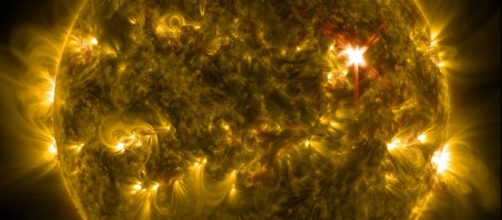A welding filter of grade 14 is dark enough to protect your eyes, but, although they are cheap, they are hard to find today at the last minute. Most welding filters aren't that dark and aren't safe to use. You can safely make a camera obscura (Pinhole camera) or even view with a spotting scope or binoculars but only using projection method, never look at the sun through anything without a Special Filter that goes on the front lens - such filters are usually highly reflective, looking like a mirror, and nothing can be seen through them except the sun.
Camera obscura - pinhole viewer
The first telescopes were just a dark room with a white wall and a tiny hole on the opposite wall. That pinhole functions as a lens. You can do this yourself using a cardboard box or even just a piece of cardboard held so the hole projects the sun’s image onto a paper on the ground.
Projection using binoculars or spotting scope
Never look at the sun through any sort of telescope without the manufacturer's solar filter, but you can use one side of binoculars or a spotting scope to project the sun’s enlarged image onto a piece of cardboard safely.
Mount the scope or binoculars on a tripod and focus them on a very distant object such as a cloud. Then point at the sun and hold a piece of white cardboard behind the eyepiece a foot or more away.
You will probably also want a large piece of cardboard with a hole cut to fit over the eyepiece and taped to scope. This will shade the viewing paper.
Reaction to solar eclipse
There is nothing unnatural about a solar eclipse, it is just the moon passing between the sun and the earth. This only works on earth because the sun and the moon both have exactly the same apparent width (one-half degree) due to their respective distance from the Earth and not their actual size.
The most interesting scientific aspect of a solar eclipse is a magnified view of the sun which sometimes shows the corona or even ejecta. Just as interesting is how animals react to a solar eclipse. The last one I was in, the birds suddenly went completely quiet, startled by the untimely darkness.
By far the best way to watch the eclipse is on one of the many websites or NASA TV. There are also scientific sites which produce daily or even live images of the sun using synthetic solar eclipses.
The photo above is something you can only see online. Since it shows the surface of the sun, it would never be possible to see this sort of detailed view during an eclipse. Features such as Baily's Beads, a flare on one side of the sun which looks exactly like a large diamond ring, are plainly visible during some solar eclipses.
Solar flares are dramatic events seldom visible during a solar eclipse but sometimes you can see them depending on how active the sun is. Before the solar eclipse, you can still see interesting things on the sun such as so-called sunspots which are magnetic storms which show areas of a slightly cooler surface.


